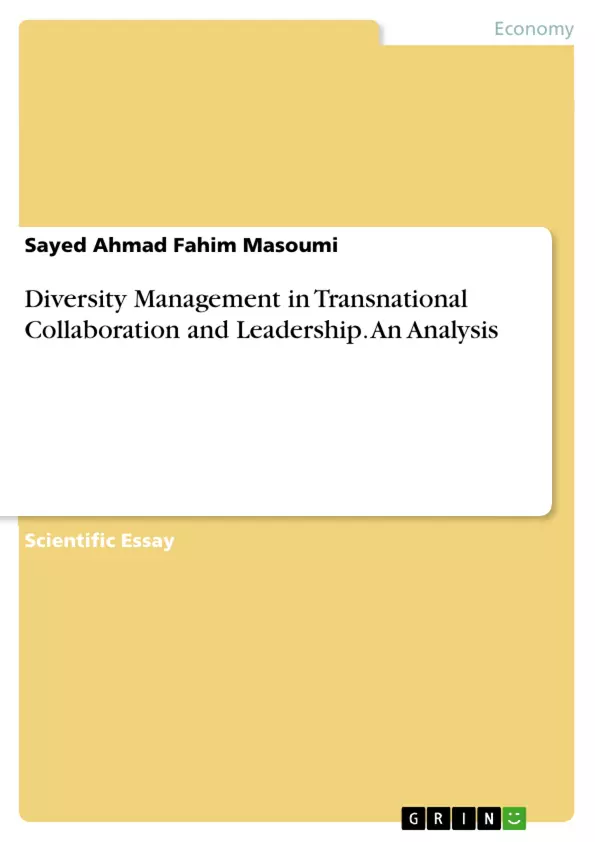Is leadership the critical driver in a transnational environment? How to ensure an inclusive organizational culture for everyone? Is gender equality a positive driver in diversity management? How, as a leader, should we follow our communication? What is there for us in using the technology for collaboration? Is migration a need for developed countries? Is there a need for training in a diverse working place? This paper explores the requirements of leading in an international environment.
There is a significant need to manage the working place inclusively considering differences in values, cultures, viewpoints, backgrounds, and several other aspects. This can happen only by wise, smart, equipped, and motivational leadership. The leader requires the right communication channel with various skills to adapt quickly to the working environment and lead the employees. In an international environment, organizational culture can be a vital element because having staff members from different cultures sends the message that something that you may think is right can be wrong from an individual perspective. It is better to know your employees fast and ensure that nothing will go wrong.
Globally, women’s involvement in the labor market can be beneficial as our worldwide economy can increase $160 trillion if we consider both males and females with equal access to the job market. In a transnational collaboration and leadership, communication can help convey the right information to the right audience in a unified and transparent way. The failure to manage the data transfer in an office can weaken trust, conflict, dispute, and other consequences. The critical human capital in the global environment comes from immigration, and the migrants have had potential contributions to the developed countries’ economic growth with their talents and expertise. There is a projection of demand for 4.3 million workforces in the next decade, and this demand can be achieved by skilling up our workforce, conducting workshops, training, and short courses.
Inhaltsverzeichnis (Table of Contents)
- 1.0 INTRODUCTION
- 1.1 METHODOLOGY
- 2.0 LEADERSHIP FOR TRANSNATIONAL COLLABORATION
- 3.0 THE ORGANIZATIONAL CULTURE.
- 4.0 GENDER EQUALITY.
- 5.0 THE ART OF COMMUNICATION.
- 6.0 THE ROLE OF TECHNOLOGY IN TRANSNATIONAL COLLABORATION.
- 7.0 THE ROLE OF IMMIGRATION IN TRANSNATIONAL COLLABORATION
- 8.0 THE ROLE OF TRAINING IN TRANSNATIONAL COLLABORATION.
- CONCLUSION
- REFERENCES
Zielsetzung und Themenschwerpunkte (Objectives and Key Themes)
This paper aims to explore the requirements of leading in an international environment, particularly focusing on managing diversity in transnational collaboration and leadership. It examines the importance of an inclusive organizational culture, the impact of gender equality, the role of communication, the influence of technology, and the contributions of immigration in a globalized workplace.
- Leadership in a Transnational Environment
- Inclusive Organizational Culture
- Gender Equality in Diversity Management
- Effective Communication in Transnational Collaboration
- The Role of Technology in Globalized Workplaces
Zusammenfassung der Kapitel (Chapter Summaries)
- 1.0 INTRODUCTION This chapter introduces the concept of diversity management in the context of globalization and its evolution from the 20th century to the present. It highlights the importance of inclusive workplaces, respect for cultural differences, and establishing a shared vision for all employees. The chapter also introduces the methodology used for the paper, which involves a literature review of printed and online sources.
- 2.0 LEADERSHIP FOR TRANSNATIONAL COLLABORATION This chapter explores the crucial role of leadership in fostering transnational collaboration and managing diversity within organizations. It emphasizes the importance of trust, respect for individual opinions, values, and cultures, and the need for leaders to be aware of their strengths, weaknesses, opportunities, and threats within the work environment.
- 3.0 THE ORGANIZATIONAL CULTURE. This chapter examines the importance of creating an organized and diverse organizational culture that values and respects differences among employees. It discusses the framework of culture and how it enhances solidarity and unity in the workplace. The chapter also provides examples of how companies like Nike have successfully adapted to different cultures through their global expansion.
- 4.0 GENDER EQUALITY. This chapter focuses on the role of gender equality in diversity management. It discusses the economic benefits of women's equal participation in the labor market and explores how gender equality can contribute to the overall success of organizations.
- 5.0 THE ART OF COMMUNICATION. This chapter highlights the significance of effective communication as a tool for bridging differences and building trust in transnational collaboration. It discusses the importance of supportive coordination, listening to diverse perspectives, and replacing rivalry with collaboration through ethical decision-making.
- 6.0 THE ROLE OF TECHNOLOGY IN TRANSNATIONAL COLLABORATION. This chapter explores the impact of technology on transnational collaboration and how it has facilitated global connections, international trade, and the growth of online banking and outsourcing. It emphasizes the need for companies to adapt their capacity-building programs to meet the demands of a technologically driven global workplace.
- 7.0 THE ROLE OF IMMIGRATION IN TRANSNATIONAL COLLABORATION This chapter examines the role of immigration in driving transnationalism. It highlights how immigration from developing countries to developed countries can contribute to workforce completion, population balance, and economic growth in the receiving countries.
Schlüsselwörter (Keywords)
This paper focuses on diversity management, transnational collaboration, leadership, inclusive organizational culture, gender equality, communication, technology, and immigration. These concepts are explored in the context of a globalized workplace and the challenges and opportunities presented by managing a diverse workforce.
- Quote paper
- Sayed Ahmad Fahim Masoumi (Author), 2021, Diversity Management in Transnational Collaboration and Leadership. An Analysis, Munich, GRIN Verlag, https://www.grin.com/document/997746



